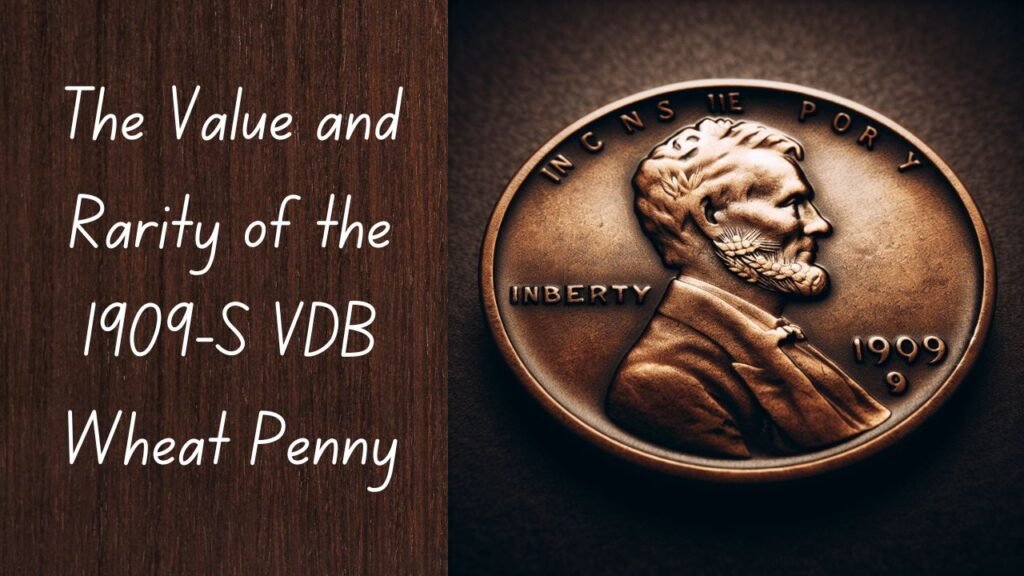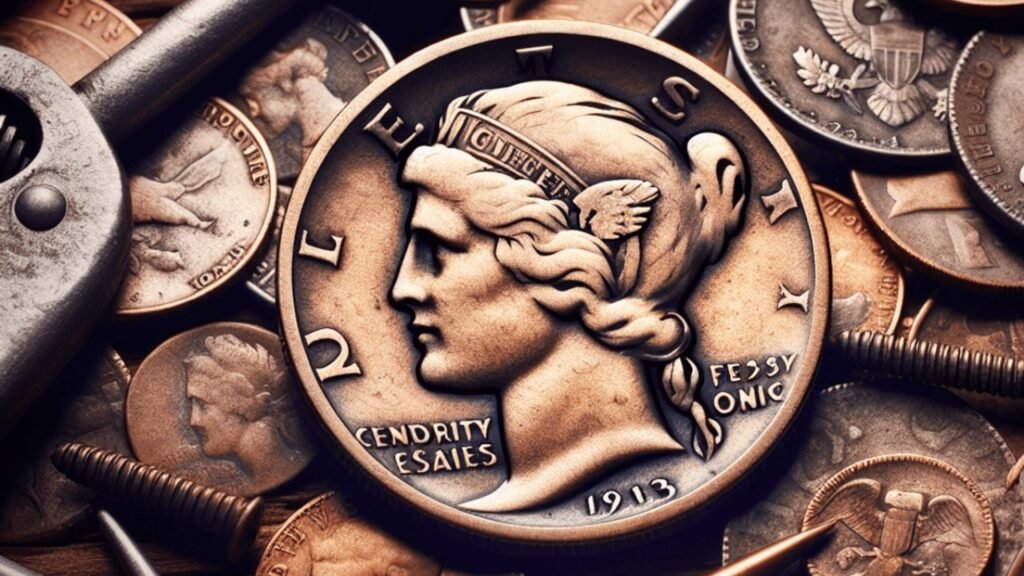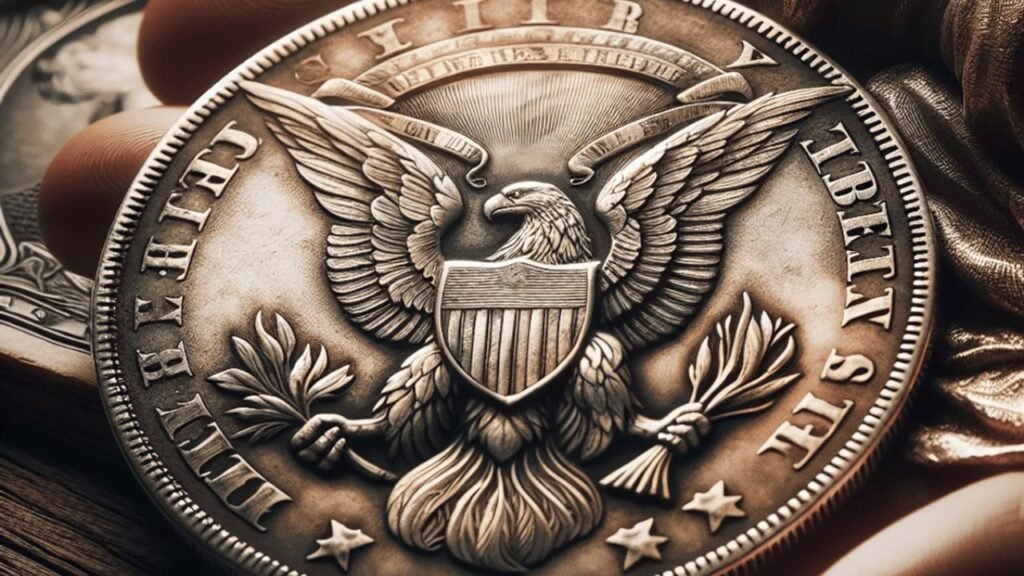Introduction
Imagine you hold a small bill worth $1 million. The legendary 1909-S VDB wheat penny is a prime example of the incredible value hidden in a rare coin. This small bronze disc bearing the initials of its maker, Victor David Brenner, has become one of the most sought-after coin treasures.
There are many other wonderful pieces waiting to be discovered in the rare collecting world. From the mysterious Liberty Head Nickel of 1913 to the historic Flowing Hair Silver Dollar of 1794, these coins tell fascinating stories of American history. In this article we will examine these treasures, including a rare 1943 copper penny and an iconic 1804 silver dollar – each with its own unique story of rarity, value and history of reason.
Understanding the 1909-S VDB Wheat Penny
The 1909-S VDB Wheat Penny is a stunning coin created by master sculptor Victor David Brenner. This design marked the first time Abraham Lincoln was featured on U.S. currency, departing from the traditional Liberty Head format.
Design Features
Brenner’s art includes:
- Front (face) Lincoln profile
- Two columns of wheat on the rear (opposite) side, framed with the words “ONE CENT” and “UNITED STATES OF AMERICA.”
- The artist’s initials VDB were prominently displayed at the bottom of the reverse side
Historical Significance
The U.S. Mint decided to make this penny design for the first time in 1909 to celebrate the 100th anniversary of Abraham Lincoln’s birth. Only 484,000 coins were produced in limited quantities at the San Francisco Mint – compared to the average penny of the time of the slightly smaller.
Controversy and Rarity
Shortly after the bill was released, there was a public outcry. Many critics felt Brenner’s early lines were too distinctive and self-promoting. In response, the U.S. Mint promptly removed the VDB signature from future pennies, making the original design even more rare.
Numismatic Value
The cessation of manufacturing turned those coins into valuable collectibles. Each remaining 1909-S VDB Wheat Penny embodies the artistic vision, historical memory and civic actions that shaped American monetary history.
The Value and Rarity of the 1909-S VDB Wheat Penny

The 1909-S VDB Wheat Penny is one of America’s most valuable coins, some in perfect condition selling for up to $1 million at auction. Several factors contribute to its price:
- Extent of Production: Only 484,000 coins were produced, accounting for 0.1% of the total 1909 penny.
- Survival rate: Very few of them are still in collectible condition today.
- Historical Significance: Located in first year Lincoln St with initials “VDB”.
Current market values for the 1909-S VDB Wheat Penny vary based on condition:
- MS-65 (Gemstone): $30,000-$50,000
- MS-67 (Very good): $150,000-$250,000
- MS-68 (almost perfect): $500,000-$1,000,000
The price of this coin has risen above many other rare coins. For example, a 1909-S VDB penny graded MS-65 sold for $4,000 in 1995 but was worth about ten times as much now. This rate of improvement is higher than other well-known rarities such as the 1914-D Lincoln Cent and 1922 Plain Penny.
Coins in good condition are prized by serious collectors, especially those with the original copper yellow color and few contact marks. These impeccable examples represent the pinnacle of achievement in the Lincoln Cent collection.
Other Notable Rare Finds for Coin Collectors
The world of numismatics holds treasures beyond the famous 1909-S VDB wheat penny. These rare coins represent important moments in American history, each with its own fascinating story.
1. 1943 Copper Wheat Penny

In 1943, there was a critical period in World War II when copper became essential for military supplies. U.S. The Mint converted the penny into zinc-coated steel to preserve copper for the war. In 1942, a handful of copper planchets were left in the coin, creating one of the most valuable mint errors in history.
These coincidental copper pennies came from three different mints.
- Philadelphia: 10-15 known specimens
- San Francisco: 6 highlighted models
- Denver: Volume 1 only
The fault occurred when residual lead from 1942 was mixed with standard 1943 steel frames. These copper plantchets went through the usual mint process, producing coins that shouldn’t exist.
The 1943 bronze wheat penny itself commands exceptional value on the collector’s market. In 2010, a prototype sold for $1.7 million at auction. The rarity of these coins makes authenticity important – there are many counterfeits, produced with copper-plated genuine 1943 steel cents or alternate dates on 1948 pennies
The main features of authentic 1943 copper coins are:
- Normal weight (3.11 grams)
- A real composition of brass
- Perfect dial quality for 1943
- No signs of brass plating or altered date
2. 1913 Liberty Head Nickel

The 1913 Liberty Head Nickel is one of the most fascinating mysteries in the world of coin collecting, a place that has seen 125 years of collecting history and only five of these coins are known, with an interesting story of creation after any unauthorized. These nickels were secretly minted at the Philadelphia Mint after the design was officially abandoned in favor of the Buffalo Nickel.
The Story Behind the Coin
The story begins with Samuel W. Brown, a former banker who first presented this coin at the 1920 ANA convention. The exact method and purpose of this coin is unknown, as there is no official record of its creation.
The Rarity and Value of the Coin
The five known examples of the 1913 Liberty Head nickel have become legends.
- Two are in museums
- Three are owned by private collectors
- The Eliasberg prototype fetched a staggering $5 million in 2007
Each specimen has received considerable interest from collectors, and is currently worth an estimated $3-5 million on the market. The combination of their mysterious origins, extreme rarity, and historical significance makes these nickels one of the most coveted items in the world of coin collecting and as collectors compete for treasures a cannot be found in supermarkets, the price continues to rise.
3. 1794 Flowing Hair Silver Dollar

Minted in 1794, the Flowing Hair Silver Dollar is the most important coin in American history. It was the first silver dollar issued by the US. The bank did, and experts believe only about 140 of them survive today.
Design and Minting Process
The design of the coin depicts Lady Liberty with flowing hair on one side and an American eagle surrounded by wreaths on the other. Every surviving coin tells us the story of the early mint technology used in America – many of them have imperfections on the Liberty neck and eagle breast due to the old pressing machinery of the time
Record-Breaking Sale
In 2013, a perfect example of this historic dollar sold for $10.02 million, making it the most expensive coin ever sold. There are three main reasons for the value of this coin:
- Its importance as the first silver dollar in America
- Different characteristics of the remaining specimens
- A direct link to the founding of the American currency
Importance to Collectors
These dollars are highly valued by collectors not only for their monetary value, but also as a tangible link to America’s founding era. The best examples exhibit a wider skull on the Liberty and crisp feather definition on the eagle, traits that greatly affect their market value.
4. 1804 Silver Dollar

The 1804 Silver Dollar is known as the “King of American Money” and is considered one of the most important coins in the world. Despite the 1804 date, the coins were actually minted in the 1830s when President Andrew Jackson ordered them to be gifted to foreign leaders
How Many 1804 Silver Dollars Are There?
Only 15 1804 Silver Dollars are known and can be divided into three different groups based on their quality.
- Class I (8 pieces): These are original coins issued as interstate gifts.
- Class II (1 piece): This is the unusual bronze in the Smithsonian Museum collection.
- Class III (6 pieces): These are later versions of coins minted in the 1850s.
The Most Expensive Coin Ever Sold
In 2021, one of the first examples of the Sultan of Muscat sold for a staggering $7.68 million, making it the most expensive coin ever sold at auction
A Unique Story Behind Each Coin
Each silver dollar still in circulation in 1804 has its own unique story to tell through its (original) ownership history. This coin was designed by Louis E. McCarthy. Famous collectors like Eliasberg Sr. and owned by the Pogue family.
Why Collectors Value These Coins
This dollar is highly valued by collectors because it has a combination of important qualities:
- They have historical significance as gifts in diplomatic relations.
- They are extremely rare.
- The approach is complex and interesting.
- They are about early American foreign relations.
The Price Range for an 1804 Silver Dollar
Silver dollars sold in 1804 had market values ranging from $2 million to $1 million, depending on composition and grade.
Conclusion
Collecting rare coins provides a unique blend of historic preservation and investment. The text on the back of pieces like the $1 Million 1909-S VDB Wheat Penny reveals the incredible value hidden in this metallic treasure. The market for rare coins continues to grow, with dedicated collectors and investors recognizing their value above precious metals.
Your journey into numismatics can start small – examining pocket change or attending a local coin show. Every currency tells a story, has historical significance, and can generate significant returns. The thrill of finding rare coins, understanding their value, and adding them to your collection creates an experience unlike any other investment venture.
FAQ’s
What is the significance of the 1909-S VDB Wheat Penny?
Designed by Victor David Brenner, the 1909-S VDB Wheat Penny was significant in American numismatics because it commemorates the centennial of Abraham Lincoln in a limited production of only 484,000 coins, and the public reacted to the mint’s discontinuation helping to make it rare and valuable.
Why is the 1909-S VDB Wheat Penny worth $1 million?
The $10 list price for the 1909-S VDB Wheat Penny is due to its rarity, high demand from collectors, and high exemplary condition These factors combine to make it one of the most sought after coins on the market.
What are other notable rare coins from collectors?
In addition to the 1909-S VDB Wheat Penny, collectors should find many other rare coins such as the 1943 Copper Wheat Penny, 1913 Liberty Head Nickel, 1794 Flowing Hair Silver Dollar, and 1804 Silver Dollar Among these coins each has a unique history what it means and what appeals to collectors .

